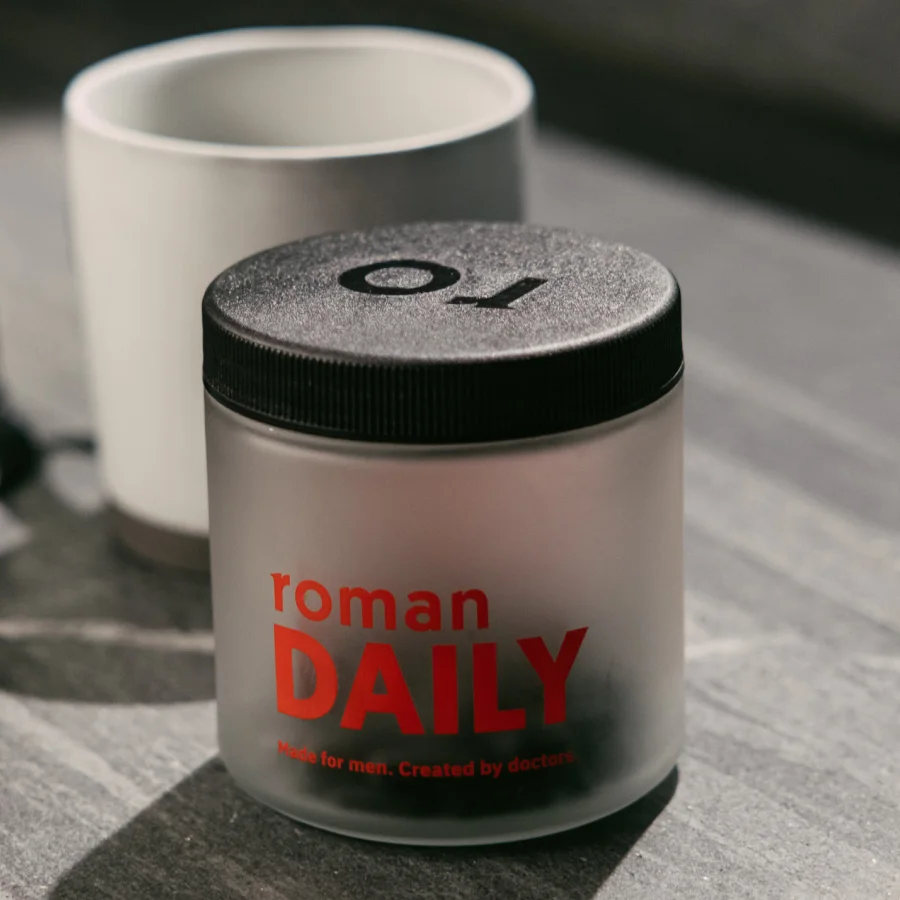Here's what we'll cover
Here's what we'll cover
Niacin is a water-soluble vitamin, meaning that you have to consume it regularly because your body does not store it. Fortunately, niacin is found in many different types of foods (more on that below).
Most Americans get enough niacin in their diets. However, there are some cases where a healthcare provider may recommend niacin supplements. Let’s learn a little more about this B vitamin, how it contributes to helping your body function properly, and what can happen if you become B3 deficient.
What is niacin (vitamin B3)?
Our body uses niacin, also known as vitamin B3, to convert the food you eat into energy and help the brain function properly, among other things.
From a biochemical perspective, niacin can refer to a lot of different molecules. For our purposes, it’s enough to understand that our body converts absorbed niacin into its main active form, nicotinamide adenine dinucleotide, or short NAD. Hundreds of enzymes require NAD for important reactions in the body. NAD can be found in the body in two forms: NAD+ or NADH (Mehmel, 2020).
Health benefits of niacin
Having enough niacin in the body is important for general good health and many bodily functions. Although more studies are needed to truly understand the impact of NAD metabolism, there is some research to suggest beneficial effects.
Here’s a look at some of the benefits of niacin and the cases when supplements may help:
Niacin and energy
Niacin helps your body use the food you eat to create energy. This happens through turning the energy from carbohydrates, fats, and proteins into a molecule called ATP (adenosine triphosphate), which powers the cells (NIH, 2021).
Niacin and the brain
While research has not shown that B vitamins can slow age-related memory loss, studies in mice revealed that NAD reduced the amount of something called “beta-amyloid plaque” in the brain. This plaque is associated with Alzheimer’s Disease. Other studies show that increasing NAD levels can help protect against neurodegenerative conditions—such as Alzheimer’s disease, dementia, and Parkinson’s disease—and may slow down their progression (Johnson, 2018; Gong, 2013).
Research also shows all of the B-vitamins play a role in keeping the brain healthy and that they often work together. That’s why vitamin b3, vitamin b6 and vitamin b12, along with folic acid, are part of a broader B-complex formulation and sold as a single dietary supplement (Kennedy, 2016).
Niacin, DNA repair, and the skin
Niacin plays an important role in repairing DNA. Too little of it has been linked to aging, neurodegenerative disease, and cancer (Croteau, 2017).
DNA repair also includes skin cell repair from sun damage. Niacinamide products—or topical niacin—may help improve some sun damage, such as wrinkles and fine lines. Studies show this form of niacin may also help prevent acne breakouts (Walocko, 2017).
Niacin and cholesterol
High doses of niacin supplements can reduce overall cholesterol. This includes decreasing the “bad” low-density lipoprotein (LDL) cholesterol and triglycerides while increasing “good” high-density lipoprotein (HDL) cholesterol. Cholesterol does have many benefits for the body, but too much can increase the risk for heart problems.
Improved blood pressure and heart health
High blood pressure and other so-called metabolic conditions take a toll on the health of blood vessels and arteries. Some research shows that NAD+ supplements can help protect blood vessels, reduce inflammation, and reduce stiffness in the aortic artery (Mehmel, 2020).
However, research does not show that niacin therapy lowers the risk of cardiovascular events like heart attack, or stroke (D’Andrea, 2019; Zeman, 2015).
Sources of niacin (vitamin B3)
Niacin can be found in many foods, including fortified foods. Most Americans get enough niacin from the food they eat. Here are some of the top meat and vegetarian food sources of niacin, and how much of the Daily Value (DV), which is similar to recommended daily allowance (RDA), they contain (NIH, 2021):
Beef liver (3 ounces [oz]): 14.9 mg; 93% of the DV
Chicken breast (3 oz): 10 mg; 63% of the DV
Turkey breast (3 oz): 10 mg; 63% of the DV
Sockeye salmon (3 oz): 8.6 mg; 54% of the DV
Brown rice (1 cup): 5.2 mg; 33% of the DV
Peanuts (1 oz): 4.2 mg; 26% of the DV
Medium baked potato: 2.3 mg; 14% of the DV
Other foods high in vitamin B3 include sunflower and pumpkin seeds, fortified bread, soy milk, lentils, bananas, raisins, tomatoes, cashews, and yogurt. The amino acid tryptophan can also be converted to NAD. Tryptophan is found in foods like turkey, chicken, fish, seeds, milk, cheese, egg whites, and soy products (NIH, 2021; NLM, 2021).
How much niacin should you take?
The following daily recommended allowances (RDAs) show the minimum amount of vitamin B3 needed based on your age group (NIH, 2021):
Men (aged 14+): 16 mg NE (one NE is defined as 1 mg of niacin) daily
Women (aged 14+): 14 mg NE daily
Women (pregnant): 18 mg daily
Women (breastfeeding): 17 mg daily
Infants 0-6 mos: 2mg niacin alone (estimated amount in breast milk)
Ages 7-12 mos: 4 mg NE
Ages 1-3: 6 mg NE(based on the amount in breast milk and solid foods)
Ages 4-8: 8 mg NE
Ages 9-13: 12 mg NE
Maximum daily intake for adults of all ages: 35 mg daily
A healthy diet typically covers the RDA of niacin. If your healthcare provider prescribes niacin, there may be instructions like taking it with food or before bed. It’s important to get medical advice from a health professional before taking niacin to make sure the dose is appropriate (NIH, 2021).
Risks and side effects of niacin
You need enough niacin for your body to function well. Yet, too much can be toxic. Here’s a look at how to identify both a niacin deficiency and an overdose:
Niacin (vitamin B3) deficiency
Before the fortification of food, niacin deficiency was fairly common in the United States. Severe niacin deficiency causes a disease called pellagra, which causes skin problems, diarrhea, dementia, and can lead to death (Redzic, 2021). Today in the U.S., cases of pellagra are rare. However, niacin deficiency can be a problem, especially for those who have a diet low in vitamin B3, tryptophan, or vitamins B1, B2, B6, or iron, which can reduce the amount of tryptophan that converts to NAD (Gasperi, 2019).
Those with vitamin B3 deficiencies often suffer from poor nutrition, anorexia, or alcoholism, which can make it harder to absorb vitamin B3. Other conditions such as inflammatory bowel disease and conditions that make it hard to absorb nutrients, such as Crohn’s disease, can also lead to a niacin deficiency. Having cancer or going through chemotherapy also increases the risk of deficiency (Gasperi, 2019).
If you have a deficiency, your healthcare provider can advise you on the best way to safely boost niacin levels based on results. Oral nicotinamide is usually used to treat a niacin deficiency (NIH, 2021; Redzic, 2021).
Niacin (vitamin B3) side effects
Niacin side effects can occur if you take supplements, especially at a high dose. It's not possible to overdose on niacin simply by eating too many niacin-rich foods. The side effects of high-dose niacin include low blood pressure, falls, fatigue, blood sugar problems, insulin resistance, nausea, heartburn, abdominal pain, and blurred vision (NIH, 2021).
Some niacin supplements have been formulated to be “sustained-release” tablets—meaning they dissolve slower in your body—to reduce the amount of flushing typically associated with niacin (NIH, 2021).
Sometimes niacin side effects are worse or lead to health problems if taken with certain drugs or supplements. Consuming alcohol and taking high-dose niacin can worsen side effects like skin flushing and increase the risk of liver damage. Those with liver disease should be cautious of taking too much vitamin B3 (NIH, 2021).
It’s best to talk with a healthcare provider before taking niacin and discuss any medications that may cause an adverse reaction. As with all vitamins, it’s best to balance vitamin B3 and ensure you have enough, but not too much (Djadjo, 2021).
DISCLAIMER
If you have any medical questions or concerns, please talk to your healthcare provider. The articles on Health Guide are underpinned by peer-reviewed research and information drawn from medical societies and governmental agencies. However, they are not a substitute for professional medical advice, diagnosis, or treatment.
Braidy, N., Berg, J., Clement, J., Khorshidi, F., Poljak, A., Jayasena, T., et al. (2019). Role of nicotinamide adenine dinucleotide and related precursors as therapeutic targets for age-related degenerative diseases: Rationale, biochemistry, pharmacokinetics, and outcomes. Antioxidants & Redox Signaling , 30 (2), 251–294. doi: 10.1089/ars.2017.7269. Retrieved from https://pubmed.ncbi.nlm.nih.gov/29634344/
Brown, B. & Wright, C. (2020). Safety and efficacy of supplements in pregnancy. Nutrition Reviews , 78 (10), 813–826. doi: 10.1093/nutrit/nuz101. Retrieved from https://www.ncbi.nlm.nih.gov/pmc/articles/PMC7558284/
Cantó, C., Menzies, K. J., & Auwerx, J. (2015). NAD+ metabolism and the control of energy homeostasis: A balancing act between mitochondria and the nucleus. Cell Metabolism , 22 (1), 31–53. doi: 10.1016/j.cmet.2015.05.023. Retrieved from https://www.ncbi.nlm.nih.gov/pmc/articles/PMC4487780/
Chi, Y. & Sauve, A. A. (2013). Nicotinamide riboside, a trace nutrient in foods, is a vitamin B3 with effects on energy metabolism and neuroprotection. Current Opinion in Clinical Nutrition and Metabolic Care , 16 (6), 657–661. doi: 10.1097/mco.0b013e32836510c0. Retrieved from https://pubmed.ncbi.nlm.nih.gov/24071780/
Croteau, D. L., Fang, E. F., Nilsen, H., & Bohr, V. A. (2017). NAD+ in DNA repair and mitochondrial maintenance. Cell Cycle , 16 (6), 491–492. doi: 10.1080/15384101.2017.1285631. Retrieved from https://www.ncbi.nlm.nih.gov/pmc/articles/PMC5384578/
D’Andrea, E., Hey, S. P., Ramirez, C. L., & Kesselheim, A. S. (2019). Assessment of the role of niacin in managing cardiovascular disease outcomes. JAMA Network Open , 2 (4). doi: 10.1001/jamanetworkopen.2019.2224. Retrieved from https://pubmed.ncbi.nlm.nih.gov/30977858/
Djadjo, S. (2021). Niacin . [Updated 2021, Jun 2]. In: StatPearls [Internet]. Retrieved from https://www.ncbi.nlm.nih.gov/books/NBK541036/
Gasperi, V., Sibilano, M., Savini, I., & Catani, M. (2019). Niacin in the central nervous system: An update of Biological Aspects and clinical applications. International Journal of Molecular Sciences , 20 (4), 974. doi: 10.3390/ijms20040974. Retrieved from https://www.ncbi.nlm.nih.gov/pmc/articles/PMC6412771/
Gong, B., Pan, Y., Vempati, P., Zhao, W., Knable, L., Ho, L., et al. (2013). Nicotinamide riboside restores cognition through an upregulation of proliferator-activated receptor-γ coactivator 1α regulated β-secretase 1 degradation and mitochondrial gene expression in alzheimer's mouse models. Neurobiology of Aging , 34 (6), 1581–1588. doi: 10.1016/j.neurobiolaging.2012.12.005. Retrieved from https://pubmed.ncbi.nlm.nih.gov/23312803/
Jahan, F. & Bagchi, R. A. (2021). Enhancing NAD+ metabolome in cardiovascular diseases: Promises and considerations. Frontiers in Cardiovascular Medicine , 8 . doi: 10.3389/fcvm.2021.716989. Retrieved from https://www.ncbi.nlm.nih.gov/pmc/articles/PMC8429781/
Johnson, S. & Imai, S. I. (2018). NAD + biosynthesis, aging, and disease. F1000Research, 7, 132. doi: 10.12688/f1000research.12120.1. Retrieved from https://www.ncbi.nlm.nih.gov/pmc/articles/PMC5795269/
Kennedy, D. (2016). B vitamins and the brain: Mechanisms, dose and efficacy—a review. Nutrients , 8 (2), 68. doi: 10.3390/nu8020068. Retrieved from https://www.ncbi.nlm.nih.gov/pmc/articles/PMC4772032/
Mehmel, M., Jovanović, N., & Spitz, U. (2020). Nicotinamide riboside-the current state of research and therapeutic uses. Nutrients , 12 (6), 1616. doi: 10.3390/nu12061616. Retrieved from https://www.ncbi.nlm.nih.gov/pmc/articles/PMC7352172/
National Institutes of Health (NIH). (n.d.). Office of dietary supplements - niacin . Retrieved Nov. 17, 2021 from https://ods.od.nih.gov/factsheets/Niacin-HealthProfessional/
Ng, C. F., Lee, C. P., Ho, A. L., & Lee, V. W. Y. (2011). Effect of niacin on erectile function in men suffering erectile dysfunction and dyslipidemia. The Journal of Sexual Medicine , 8 (10), 2883–2893. doi: 10.1111/j.1743-6109.2011.02414.x. Retrieved from https://pubmed.ncbi.nlm.nih.gov/21810191/
Redzic, S. (2021). Niacin deficiency . [Updated 2021, May 24]. In: StatPearls [Internet]. Retrieved from https://www.ncbi.nlm.nih.gov/books/NBK557728/
Shi, H., Enriquez, A., Rapadas, M., Martin, E. M. M. A., Wang, R., Moreau, J., et al. (2017). NAD deficiency, congenital malformations, and niacin supplementation. New England Journal of Medicine , 377 (6), 544–552. doi: 10.1056/nejmoa1616361. Retrieved from https://www.nejm.org/doi/full/10.1056/NEJMoa1616361
U.S. National Library of Medicine. (n.d.). Tryptophan: Medlineplus medical encyclopedia . MedlinePlus. Retrieved Nov. 17, 2021 from https://medlineplus.gov/ency/article/002332.htm
Walocko, F. M., Eber, A. E., Keri, J. E., AL-Harbi, M. A., & Nouri, K. (2017). The role of nicotinamide in acne treatment. Dermatologic Therapy , 30 (5). doi: 10.1111/dth.12481. Retrieved from https://pubmed.ncbi.nlm.nih.gov/28220628/
Wang, W. & Liang, B. (2012). Case report of mental disorder induced by niacin deficiency. Shanghai Archives of Psychiatry. Retrieved from https://www.ncbi.nlm.nih.gov/pmc/articles/PMC4198903/8
Wilk, A., Hayat, F., Cunningham, R., Li, J., Garavaglia, S., Zamani, L., et al. (2020). Extracellular NAD+ enhances PARP-dependent DNA repair capacity independently of CD73 activity. Nature News . Retrieved from https://www.nature.com/articles/s41598-020-57506-9
Xu, X. J. & Jiang, G. S. (2015). Niacin-respondent subset of schizophrenia – a therapeutic review. European Review for Medical and Pharmacological Sciences, 19 (6), 988–997. Retrieved from https://pubmed.ncbi.nlm.nih.gov/25855923/
Yang, Y. & Sauve, A. A. (2021). Assays for determination of cellular and mitochondrial NAD+ and NADH content. Methods in Molecular Biology , 271–285. doi: 10.1007/978-1-0716-1433-4_15. Retrieved from https://pubmed.ncbi.nlm.nih.gov/34096008/
Zemen, M. (2015). Niacin in the treatment of Hyperlipidemias in light of new clinical trials: Has niacin lost its place? Medical Science Monitor , 21 , 2156–2162. doi: 10.12659/msm.893619. Retrieved from https://www.ncbi.nlm.nih.gov/pmc/articles/PMC4523006/










